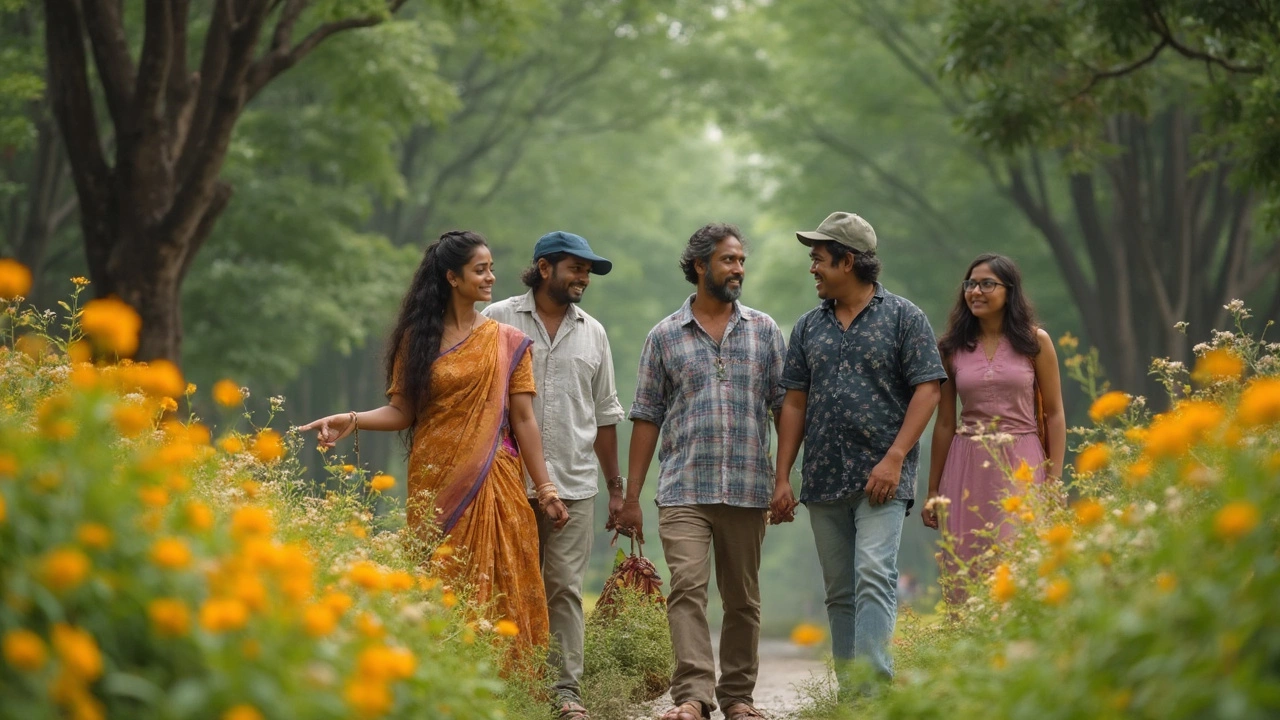Ever catch yourself scrolling through someone else's wild road trip photos, thinking, "Why can't I do something like that?" It's not as hard as it looks. Real-life adventures don't have to mean selling everything and buying a van or hiking across Antarctica. They can start right where you are, even if you just have a free Saturday and no fancy gear.
Most people think adventure has to be extreme, expensive, or Instagram-ready. That mindset holds you back. The trick is to see adventure as anything that shakes up your routine: trying a new trail, signing up for an improv class, geocaching at the park with your kids, or saying yes to something that makes you nervous. You don’t need special skills—just the guts to say, “Let’s try it.”
Small steps count. Last month, my son Quentin and I biked through a muddy nature reserve we’d never seen, discovered what was possibly the world’s largest anthill, and honestly, it felt epic. You don’t need to fly to Thailand to find that feeling (though, that’d be cool too). Break the habit of waiting for the 'perfect' opportunity—adventure is like a muscle, the more you use it, the bolder you get.
- Why We All Crave Adventure
- How to Start Small: Everyday Quests
- Overcoming Excuses and Fear
- Turning Ordinary Moments Into Wild Tales
- Bringing Family and Friends Along
- Capturing and Sharing Your Story
Why We All Crave Adventure
Ever notice how kids turn even a backyard bush into a jungle? That drive doesn’t go away—we just get distracted by work, chores, and streaming shows. Our brains are wired for new experiences; it’s part of staying curious and sharp. Dopamine spikes when you try something unfamiliar, and that’s the feel-good chemical linked with excitement and motivation.
Studies from Stanford and the University of Pittsburgh show that people who do something new, even if it’s small, feel more alive and less stressed. In 2023, a survey by the Outdoor Foundation showed that over 50% of adults who picked up a new outdoor hobby felt happier and less anxious than those who stuck to routines.
So, why the urge for a real-life adventure? Turns out, getting outside your comfy bubble actually resets your mind. Even simple adventures, like exploring a hidden part of your own town, can boost your mood and give you stories worth telling at dinner.
| Benefit | How Many People Reported It (2023) |
|---|---|
| Less Stress | 57% |
| More Happiness | 52% |
| Better Relationships | 31% |
Bottom line: adventure feeds curiosity, confidence, and your mental health. No wonder we crave it, even if we forget. It’s how we get out of autopilot and into moments we actually remember.
How to Start Small: Everyday Quests
If you're waiting for an epic quest to fall in your lap, you'll be waiting ages. The real magic happens when you make your own adventure, starting with what's right in your neighborhood. The trick is to look at everyday stuff through a new lens (and sometimes a map).
Some of the best real-life adventures begin as simple challenges. Take urban hiking—most city people walk about 3,000 to 4,000 steps a day, which is far less than the recommended 10,000. What if you set a goal to explore every park or hidden alley in your area over the next month? Suddenly you’re discovering murals, food trucks, or shortcuts you didn’t know existed. Bonus: you move more and start seeing your world differently.
Try these ideas to get the ball rolling:
- Pick a spot on a map within 10 miles you’ve never visited and go—no matter how random.
- Challenge yourself (or your kids) to a "yes day" where you say yes to safe, spontaneous plans.
- Sign up for a community class you’d usually skip, like archery, pottery, or a local history walk.
- Tackle a public bike trail, even if you’ve always driven by it and thought, "maybe next time."
- If you have young kids, try a backyard campout—even if it’s a bit chilly and the dog keeps stealing marshmallows.
The cool thing is, adventure spills over. My daughter Thalia once wrangled us into a random comic book festival—never my thing, but it turned out hilarious. These bite-sized quests build your "Why not?" muscles. After a few, you'll notice you start seeking more, and getting others in on the fun.
The only rule: keep moving and keep it fresh. You don’t need to post every outing on social media. The real reward is having those stories tucked away for family dinners or lazy Sunday mornings.
Real-life adventure doesn't start with plane tickets—it starts with one curious step out the door.
Overcoming Excuses and Fear
Let’s be honest, most real-life adventures never happen because we talk ourselves out of them. "I’m too tired." "It’ll cost too much." "I don’t have time." Everyone’s said it. But here's a fact: studies from Stanford University have shown that even a quick walk outside can boost creativity and mood. That means you’re probably missing out on feeling better, not just on the fun stuff.
Fear lurks in the background too—worrying something could go wrong, or you’ll look silly. But psychologists agree that stepping out of your comfort zone even a little helps you deal with stress and builds confidence. A good experiment? Pick one minor thing you’re worried about—like asking a neighbor to join a pick-up soccer game or trying your hand at rock climbing at the gym. You’ll usually find that it’s not nearly as scary as your brain wants you to believe.
- Start with something small. You don’t have to aim for a three-day trek right away. Try a new food, take a different route to work, or go to a local event solo.
- Let your family know why you want to break the daily routine. When I explained it to my daughter Thalia, she actually helped come up with ideas that sounded doable (and less nerve-racking).
- Make a quick pros and cons list. Most of the reasons not to do something tend to sound a bit lame when you see them written down. The upside usually outweighs them.
- Set a date—don’t leave it open-ended. Pick a weekend, mark it on the calendar, and stick to it.
Real growth starts when you push past the excuses and give new things a shot. When you treat real-life adventure as something anyone can do, it gets a lot less intimidating. One step is sometimes all it takes to clear a path for the next one.

Turning Ordinary Moments Into Wild Tales
Any moment can become a story worth telling. The key is looking at your regular life with the curiosity you’d have if you were dropped into a new city. When you treat a local park, a late-night convenience store run, or even your commute as a mini-expedition, you notice more. Come home with a story instead of just a checked-off to-do list.
Families who make a habit out of adding a game or funny challenge to routine—think "Find the weirdest item in the grocery aisle" or "Take a detour on the way home and see where you end up"—end up connecting more and laughing about it later. Making these moments matter is about intention, not intensity.
Here’s how you can turn the everyday into an actual adventure:
- Set a playful challenge each week—like cooking a new recipe from another country or learning a new backyard game.
- Let your kids or partner pick a random spot on the map and go explore, even if it’s only fifteen minutes away.
- Say yes to last-minute invitations, even if you’re not sure what to expect.
- Keep a notebook or phone log—jot down the odd, funny, or surprising moments. You’ll be amazed at how wild even the quiet suburbs can get.
Studies show families who try real-life adventure activities together have stronger relationships and even lower their stress. A 2023 survey by the American Institute of Family Life found that 62% of parents who adventure regularly with their kids report fewer arguments at home.
| Activity | Reported Happiness Boost (%) |
|---|---|
| Trying new local food | 47 |
| Spontaneous day trips | 61 |
| Scavenger hunts | 54 |
| Night walks | 39 |
Sure, you might not end up on a survival show, but you’ll have fresher stories and closer bonds. Ordinary moments are just adventures hiding in plain sight. The only trick is treating them that way.
Bringing Family and Friends Along
Adventure can get a lot more fun—and sometimes a lot crazier—when you rope others in. But let's be honest, not everyone wants to jump out of their comfort zone at the same speed. If you’ve got a spouse who’s glued to their phone, a teen who groans at the word “hike,” or friends who bail when plans get real, you’re not alone. The good news: anyone can join a real-life adventure with the right approach.
Start by keeping it simple and familiar. Studies from the Outdoor Foundation show that first-timers are far more likely to say yes to low-pressure outings close to home, like a picnic at a new park or a board game night under the stars. Once people get a taste for something different—and realize nobody’s being forced to eat freeze-dried bugs—they loosen up.
- Offer choices. Don’t make it a one-option deal. Let your crew help pick the activity or spot. They’ll feel more invested.
- Keep the mood light. If the adventure flops, don’t make it a big deal. Laugh it off. That’s usually what turns into the best story anyway.
- Plan for all ages and abilities. If you’re dragging the kids, check for stroller-friendly trails, bathrooms, or playgrounds. Snacks work wonders for morale.
- Make it a “no phones” zone—at least for a while. When everyone is actually there, not distracted by screens, they remember the experience way better. The American Academy of Pediatrics even suggests that device-free time outdoors helps families bond.
It helps to share clear info before you go. Nobody likes surprise 7-mile hikes when they’re expecting a short stroll. Remind everyone what to bring—water, jackets, maybe a goofy hat. When you get home, let everyone tell their version of the story. Suddenly, your ordinary afternoon turns into a classic real-life adventure tale that the group owns together.
Capturing and Sharing Your Story
Here’s the thing: If you don’t record your real-life adventure, it disappears into yesterday’s memory. That doesn’t mean becoming a full-time vlogger, but snapping a few photos, jotting some notes, or shooting little videos makes your adventure last longer—and sharing it encourages others too. According to a 2023 Statista study, over 80% of U.S. adults share photos or videos from trips online, and almost 60% say they’re inspired to try new things after seeing friends’ adventures.
Not sure where to start? Break it down:
- Pick your flavor: Some people like journals, others post on Instagram, record voice memos, or make mini YouTube shorts. Use whatever’s easy for you.
- Don’t overthink the quality. A blurry selfie with muddy boots still tells a better story than nothing at all.
- Write down at least one thing you learned or laughed at for every outing—the stuff you forget is usually the best part to look back on.
- Ask your kids or friends to add their own photos or thoughts. If you’re shy about sharing, just keep it in a private family album. My daughter Thalia’s doodles from our last scavenger hunt are now family legends.
If you’re sharing online, don’t just post perfect shots. People connect with the real moments—mess-ups, wrong turns, and funny fails. These stories make your real-life adventure stick with folks way more than just showing off pretty landscapes.
| Capture Method | Pros | Cons |
|---|---|---|
| Smartphone Photos | Always on hand, quick results | Limited in low light, easy to forget to take |
| Journaling | Catches emotions, works offline | Takes more effort, not as instant |
| Video Clips | Brings moments to life, sound included | Takes up storage, requires editing |
| Voice Memos | Hands-free, captures thoughts | Harder to share, not visual |
| Shared Albums | Private or public, easy for family | Needs group buy-in, privacy settings |
Don’t let the pressure to "go viral" ruin it. Do it for future you—so you and your crew can relive those wins, the setbacks, and the laugh-out-loud moments. That’s how regular days start feeling epic, and your stories go from forgotten to legendary in your world.

